RENAULT TWINGO RS 2009 2.G Electrical Equipment - Multimedia Connection Workshop Manual
Manufacturer: RENAULT, Model Year: 2009, Model line: TWINGO RS, Model: RENAULT TWINGO RS 2009 2.GPages: 48, PDF Size: 0.29 MB
Page 1 of 48
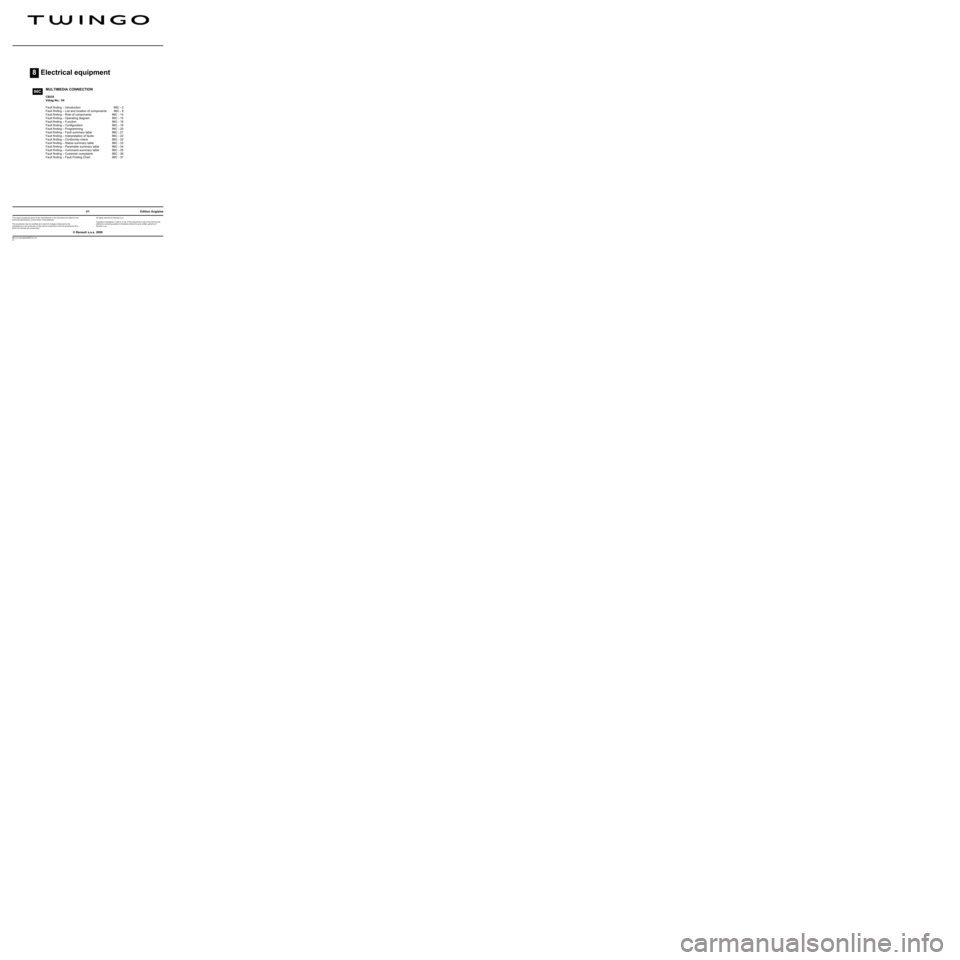
8Electrical equipment
V1 MR-413-X44-86C000$TOC.mif
V1
86C
"The repair procedures given by the manufacturer in this document are based on the
technical specifications current when it was prepared.
The procedures may be modified as a result of changes introduced by the
manufacturer in the production of the various component units and accessories from
which his vehicles are constructed."
V1
All rights reserved by Renault s.a.s.
Edition Anglaise
Copying or translating, in part or in full, of this document or use of the service part
reference numbering system is forbidden without the prior written authority of
Renault s.a.s.
© Renault s.a.s. 2009
MULTIMEDIA CONNECTION
CBOX
Vdiag No.: 04
Fault finding – Introduction 86C - 2
Fault finding – List and location of components 86C - 8
Fault finding – Role of components 86C - 14
Fault finding – Operating diagram 86C - 15
Fault finding – Function 86C - 18
Fault finding – Configuration 86C - 19
Fault finding – Programming 86C - 20
Fault finding – Fault summary table 86C - 21
Fault finding – Interpretation of faults 86C - 22
Fault finding – Conformity check 86C - 32
Fault finding – Status summary table 86C - 33
Fault finding – Parameter summary table 86C - 34
Fault finding – Command summary table 86C - 35
Fault finding – Customer complaints 86C - 36
Fault finding – Fault Finding Chart 86C - 37
Page 2 of 48
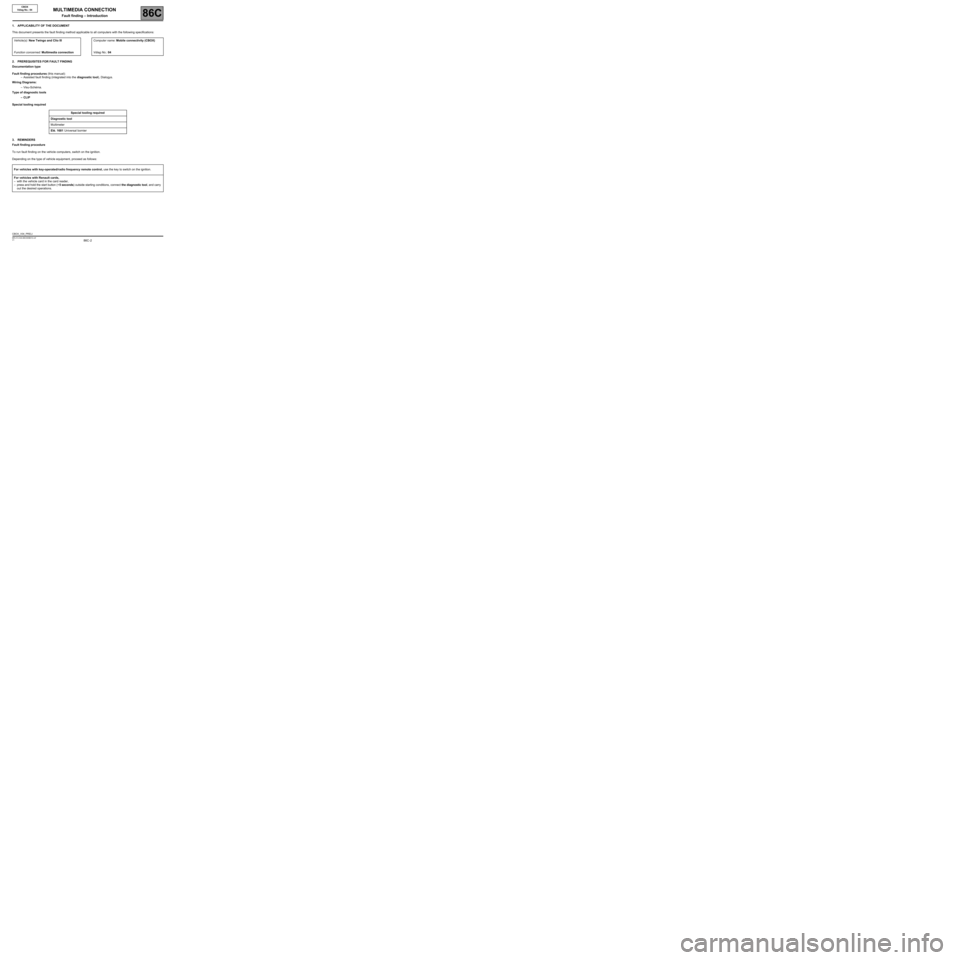
86C -2V1 MR-413-X44-86C000$010.mif
86C
CBOX
Vdiag No.: 04
1. APPLICABILITY OF THE DOCUMENT
This document presents the fault finding method applicable to all computers with the following specifications:
2. PREREQUISITES FOR FAULT FINDING
Documentation type
Fault finding procedures (this manual):
–Assisted fault finding (integrated into the diagnostic tool), Dialogys.
Wiring Diagrams:
–Visu-Schéma.
Type of diagnostic tools
–CLIP
Special tooling required
3. REMINDERS
Fault finding procedure
To run fault finding on the vehicle computers, switch on the ignition.
Depending on the type of vehicle equipment, proceed as follows:Vehicle(s): New Twingo and Clio IIIComputer name: Mobile connectivity (CBOX)
Function concerned: Multimedia connectionVdiag No.: 04
Special tooling required
Diagnostic tool
Multimeter
Elé. 1681 Universal bornier
For vehicles with key-operated/radio frequency remote control, use the key to switch on the ignition.
For vehicles with Renault cards,
–with the vehicle card in the card reader,
–press and hold the start button (+5 seconds) outside starting conditions, connect the diagnostic tool, and carry
out the desired operations.
CBOX_V04_PRELI
MULTIMEDIA CONNECTION
Fault finding – Introduction
Page 3 of 48

86C -3V1 MR-413-X44-86C000$010.mif
MULTIMEDIA CONNECTION
Fault finding – Introduction86C
CBOX
Vdiag No.: 04
To cut off the + after ignition feed, proceed as follows:
Faults
Faults are declared either present or stored (depending on whether they appeared in a certain context and have
disappeared since, or whether they remain present but have not been diagnosed within the current context).
The present or stored status of faults should be taken into consideration when the diagnostic tool is used after the
+ after ignition feed has been activated (without any of the system components being activated).
For a present fault, apply the procedure described in the Interpretation of faults section.
For a stored fault, note the faults displayed and apply the Notes section.
If the fault is confirmed when the instructions are applied, the fault is present. Deal with the fault.
If the fault is not confirmed, check:
–the electrical lines which correspond to the fault,
–the connectors on these lines (corrosion, bent pins, etc.),
–the resistance of the component detected as faulty,
–the condition of the wires (melted or split insulation, wear).
Conformity check
The aim of the conformity check is to check the data that does not display a fault on the diagnostic tool when the
data is inconsistent. Therefore, this stage is used to:
–carry out fault finding on faults that do not have a fault display, and which may correspond to a customer complaint.
–check that the system is operating correctly and that there is no risk of a fault recurring after repair.
This section gives the fault finding procedures for statuses and parameters and the conditions for checking them.
If a status is not behaving normally or a parameter is outside the permitted tolerance values, consult the
corresponding fault finding page.
Customer complaints - Fault finding chart
If the test with the diagnostic tool is OK but the customer complaint is still present, the fault should be processed by
customer complaints. For vehicles with radio frequency remote control/key, use the key to switch off the ignition.
For vehicles with Renault cards,
Press the Start button twice briefly (less than 3 seconds),
Ensure that the forced + after ignition feed has been cut off by checking that the computer warning lights on the
instrument panel have gone out.
A synopsis of the general procedure to follow is provided on the following page in the form of a flow chart.
Page 4 of 48
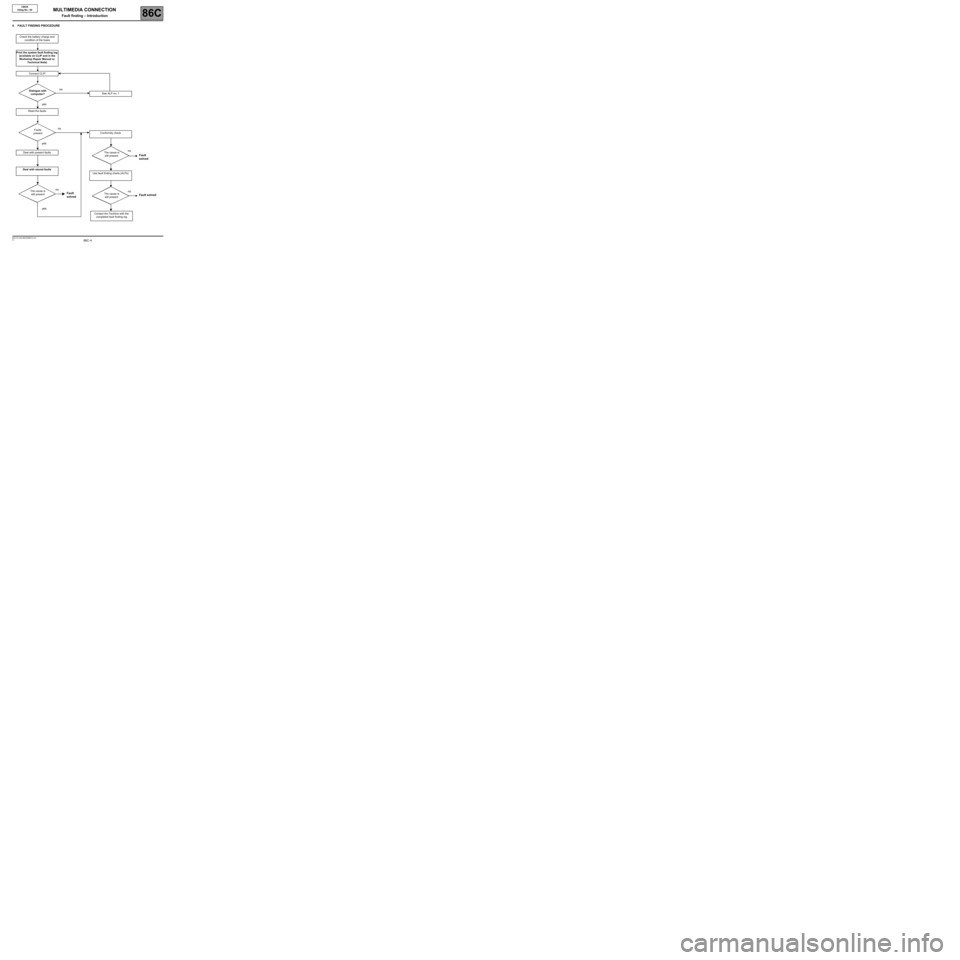
86C -4V1 MR-413-X44-86C000$010.mif
MULTIMEDIA CONNECTION
Fault finding – Introduction86C
CBOX
Vdiag No.: 04
4. FAULT FINDING PROCEDURE
Check the battery charge and
condition of the fuses
Print the system fault finding log
(available on CLIP and in the
Workshop Repair Manual or
Technical Note)
Connect CLIP
See ALP no. 1
Read the faults
Deal with present faults
Deal with stored faults
Conformity check
Use fault finding charts (ALPs)
Dialogue with
computer?
Faults
present
The cause is
still present
The cause is
still presentThe cause is
still present
no
nono
no no
yes
yes
yesFault
solvedFault solved Fault
solved
Contact the Techline with the
completed fault finding log
Page 5 of 48
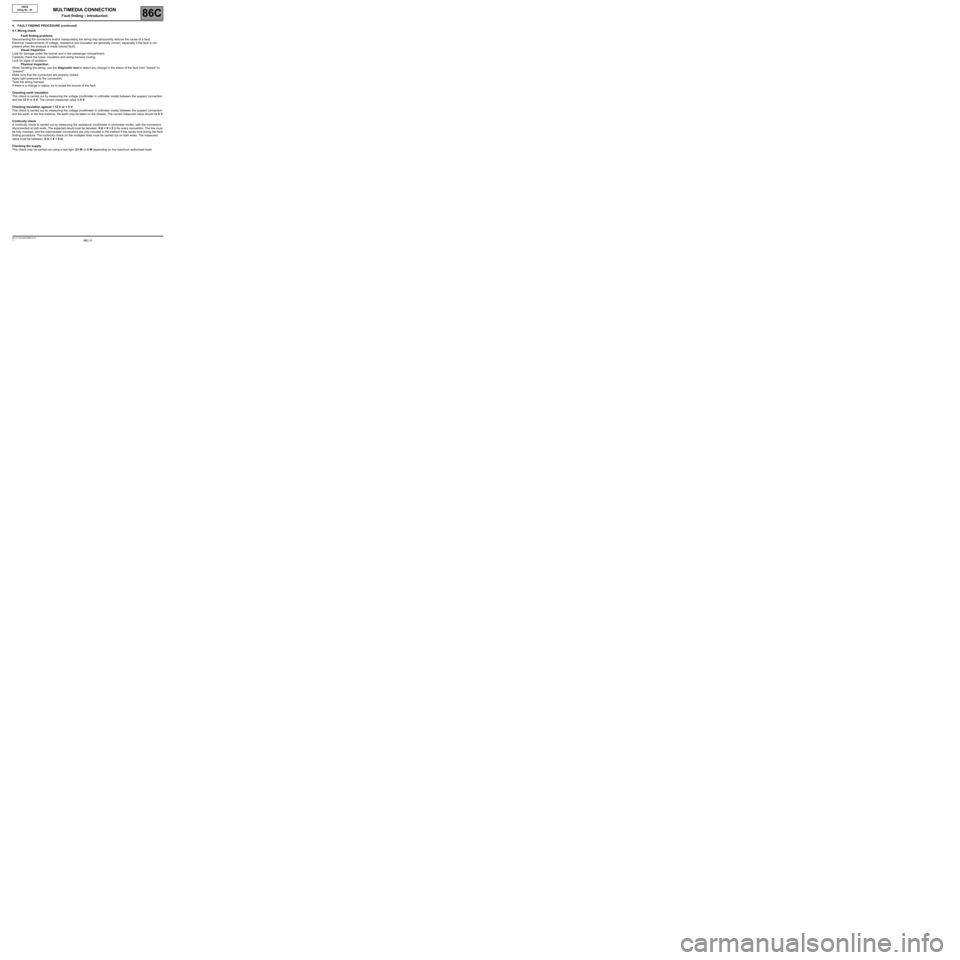
86C -5V1 MR-413-X44-86C000$010.mif
MULTIMEDIA CONNECTION
Fault finding – Introduction86C
CBOX
Vdiag No.: 04
4. FAULT FINDING PROCEDURE (continued)
4.1. Wiring check
Fault finding problems
Disconnecting the connectors and/or manipulating the wiring may temporarily remove the cause of a fault.
Electrical measurements of voltage, resistance and insulation are generally correct, especially if the fault is not
present when the analysis is made (stored fault).
Visual inspection
Look for damage under the bonnet and in the passenger compartment.
Carefully check the fuses, insulators and wiring harness routing.
Look for signs of oxidation.
Physical inspection
When handling the wiring, use the diagnostic tool to detect any change in the status of the fault from "stored" to
"present".
Make sure that the connectors are properly locked.
Apply light pressure to the connectors.
Twist the wiring harness.
If there is a change in status, try to locate the source of the fault.
Checking earth insulation
This check is carried out by measuring the voltage (multimeter in voltmeter mode) between the suspect connection
and the 12 V or 5 V. The correct measured value is 0 V.
Checking insulation against + 12 V or + 5 V
This check is carried out by measuring the voltage (multimeter in voltmeter mode) between the suspect connection
and the earth. In the first instance, the earth may be taken on the chassis. The correct measured value should be 0 V
Continuity check
A continuity check is carried out by measuring the resistance (multimeter in ohmmeter mode), with the connectors
disconnected at both ends. The expected result must be between: 0 ΩΩ Ω Ω
< X < 2 Ω for every connection. The line must
be fully checked, and the intermediate connections are only included in the method if this saves time during the fault
finding procedure. The continuity check on the multiplex lines must be carried out on both wires. The measured
value must be between: 0 ΩΩ Ω Ω
< X < 2 ΩΩ Ω Ω
.
Checking the supply
This check may be carried out using a test light (21 W or 5 W depending on the maximum authorised load)
Page 6 of 48
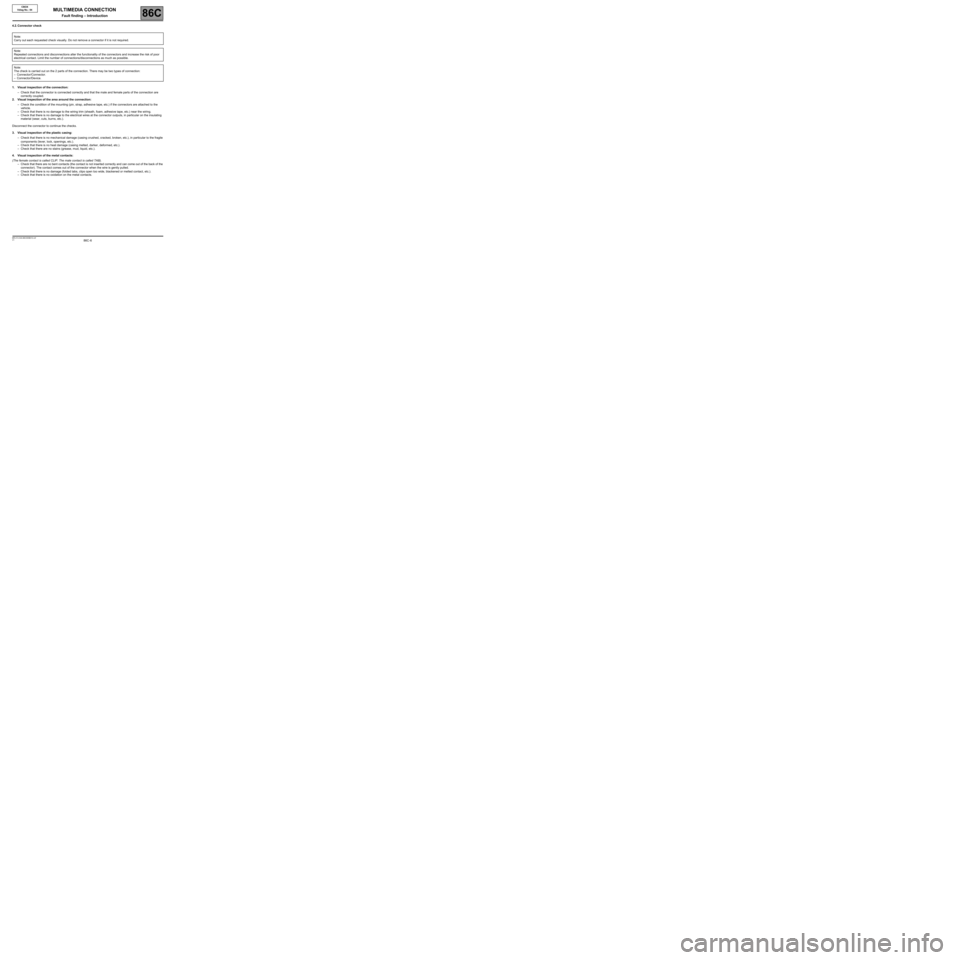
86C -6V1 MR-413-X44-86C000$010.mif
MULTIMEDIA CONNECTION
Fault finding – Introduction86C
CBOX
Vdiag No.: 04
4.2. Connector check
1. Visual inspection of the connection:
–Check that the connector is connected correctly and that the male and female parts of the connection are
correctly coupled.
2. Visual inspection of the area around the connection:
–Check the condition of the mounting (pin, strap, adhesive tape, etc.) if the connectors are attached to the
vehicle.
–Check that there is no damage to the wiring trim (sheath, foam, adhesive tape, etc.) near the wiring.
–Check that there is no damage to the electrical wires at the connector outputs, in particular on the insulating
material (wear, cuts, burns, etc.).
Disconnect the connector to continue the checks.
3. Visual inspection of the plastic casing:
–Check that there is no mechanical damage (casing crushed, cracked, broken, etc.), in particular to the fragile
components (lever, lock, openings, etc.).
–Check that there is no heat damage (casing melted, darker, deformed, etc.).
–Check that there are no stains (grease, mud, liquid, etc.).
4. Visual inspection of the metal contacts:
(The female contact is called CLIP. The male contact is called TAB).
–Check that there are no bent contacts (the contact is not inserted correctly and can come out of the back of the
connector). The contact comes out of the connector when the wire is gently pulled.
–Check that there is no damage (folded tabs, clips open too wide, blackened or melted contact, etc.).
–Check that there is no oxidation on the metal contacts. Note:
Carry out each requested check visually. Do not remove a connector if it is not required.
Note:
Repeated connections and disconnections alter the functionality of the connectors and increase the risk of poor
electrical contact. Limit the number of connections/disconnections as much as possible.
Note:
The check is carried out on the 2 parts of the connection. There may be two types of connection:
–Connector/Connector.
–Connector/Device.
Page 7 of 48
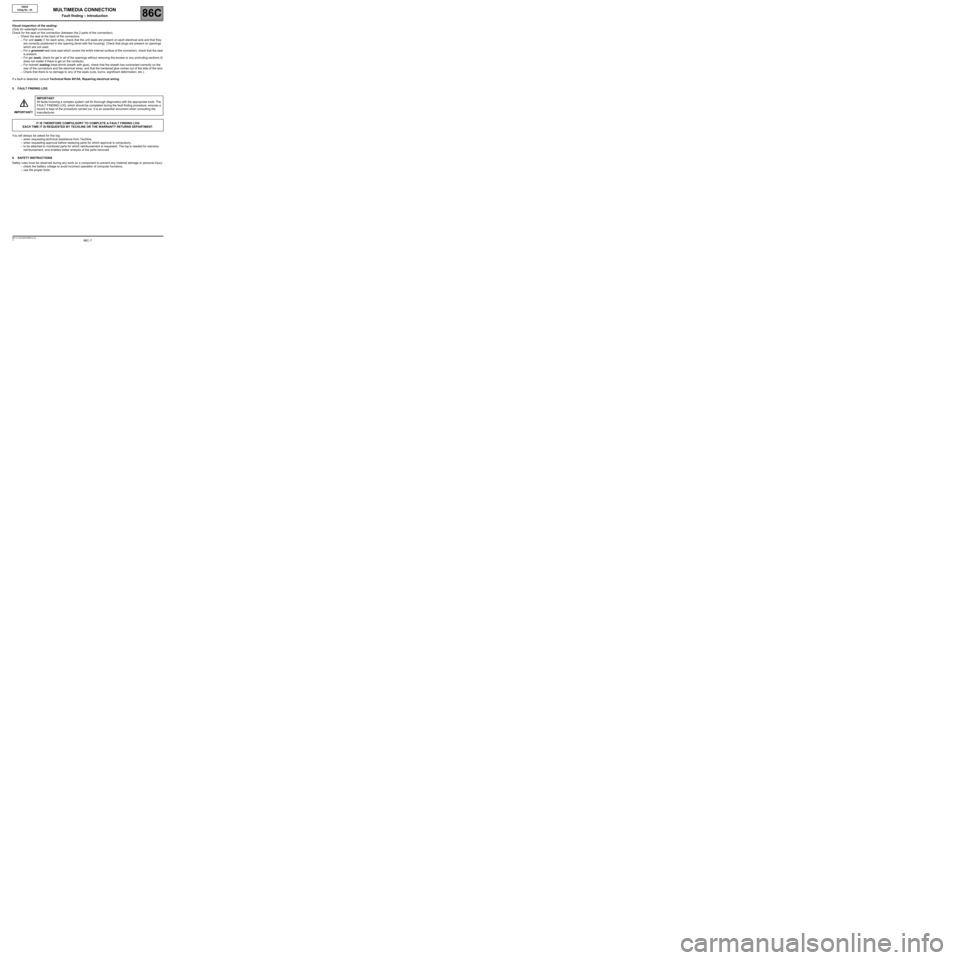
86C -7V1 MR-413-X44-86C000$010.mif
MULTIMEDIA CONNECTION
Fault finding – Introduction86C
CBOX
Vdiag No.: 04
Visual inspection of the sealing:
(Only for watertight connectors)
Check for the seal on the connection (between the 2 parts of the connection).
–Check the seal at the back of the connectors:
–For unit seals (1 for each wire), check that the unit seals are present on each electrical wire and that they
are correctly positioned in the opening (level with the housing). Check that plugs are present on openings
which are not used.
–For a grommet seal (one seal which covers the entire internal surface of the connector), check that the seal
is present.
–For gel seals, check for gel in all of the openings without removing the excess or any protruding sections (it
does not matter if there is gel on the contacts).
–For hotmelt sealing (heat-shrink sheath with glue), check that the sheath has contracted correctly on the
rear of the connectors and the electrical wires, and that the hardened glue comes out of the side of the wire.
–Check that there is no damage to any of the seals (cuts, burns, significant deformation, etc.).
If a fault is detected, consult Technical Note 6015A, Repairing electrical wiring.
5. FAULT FINDING LOG
You will always be asked for this log:
–when requesting technical assistance from Techline,
–when requesting approval before replacing parts for which approval is compulsory,
–to be attached to monitored parts for which reimbursement is requested. The log is needed for warranty
reimbursement, and enables better analysis of the parts removed.
6. SAFETY INSTRUCTIONS
Safety rules must be observed during any work on a component to prevent any material damage or personal injury:
–check the battery voltage to avoid incorrect operation of computer functions,
–use the proper tools. IMPORTANT!IMPORTANT
All faults involving a complex system call for thorough diagnostics with the appropriate tools. The
FAULT FINDING LOG, which should be completed during the fault finding procedure, ensures a
record is kept of the procedure carried out. It is an essential document when consulting the
manufacturer.
IT IS THEREFORE COMPULSORY TO COMPLETE A FAULT FINDING LOG
EACH TIME IT IS REQUESTED BY TECHLINE OR THE WARRANTY RETURNS DEPARTMENT.
Page 8 of 48
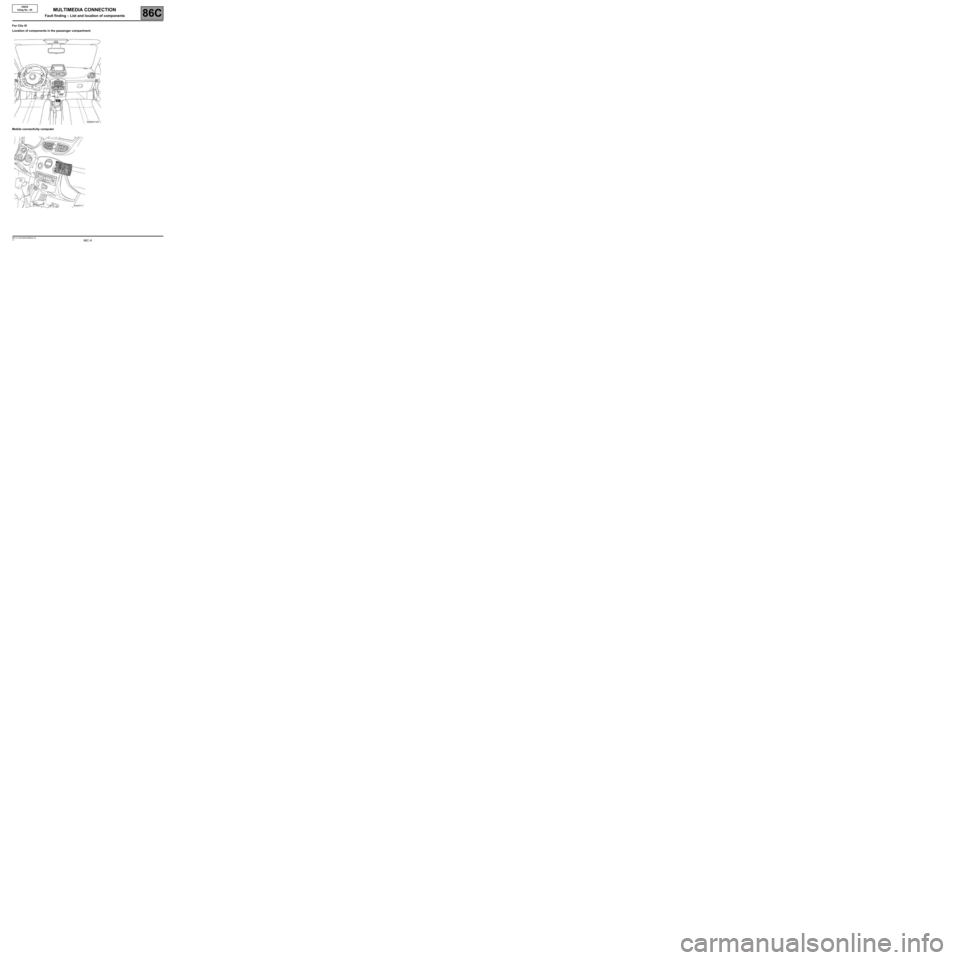
86C -8V1 MR-413-X44-86C000$020.mif
86C
CBOX
Vdiag No.: 04
For Clio III
Location of components in the passenger compartment
Mobile connectivity computer
MULTIMEDIA CONNECTION
Fault finding – List and location of components
Page 9 of 48
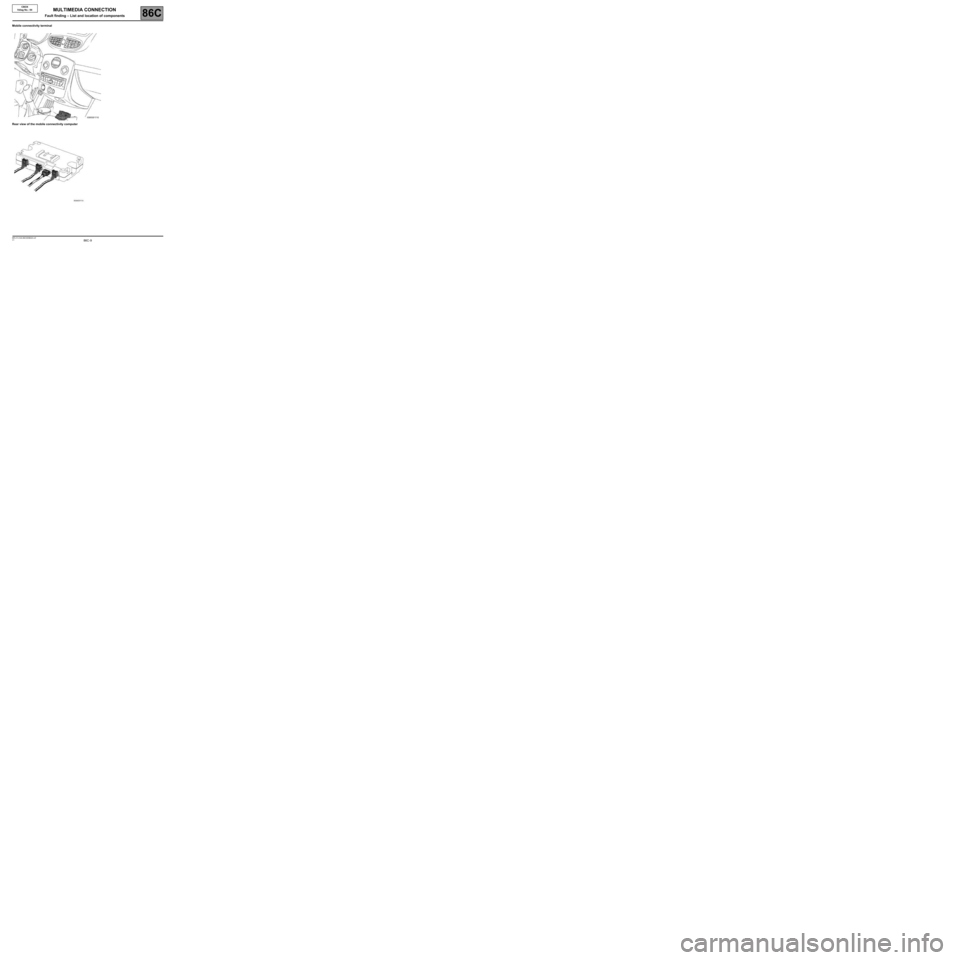
86C -9V1 MR-413-X44-86C000$020.mif
MULTIMEDIA CONNECTION
Fault finding – List and location of components86C
CBOX
Vdiag No.: 04
Mobile connectivity terminal
Rear view of the mobile connectivity computer
Page 10 of 48
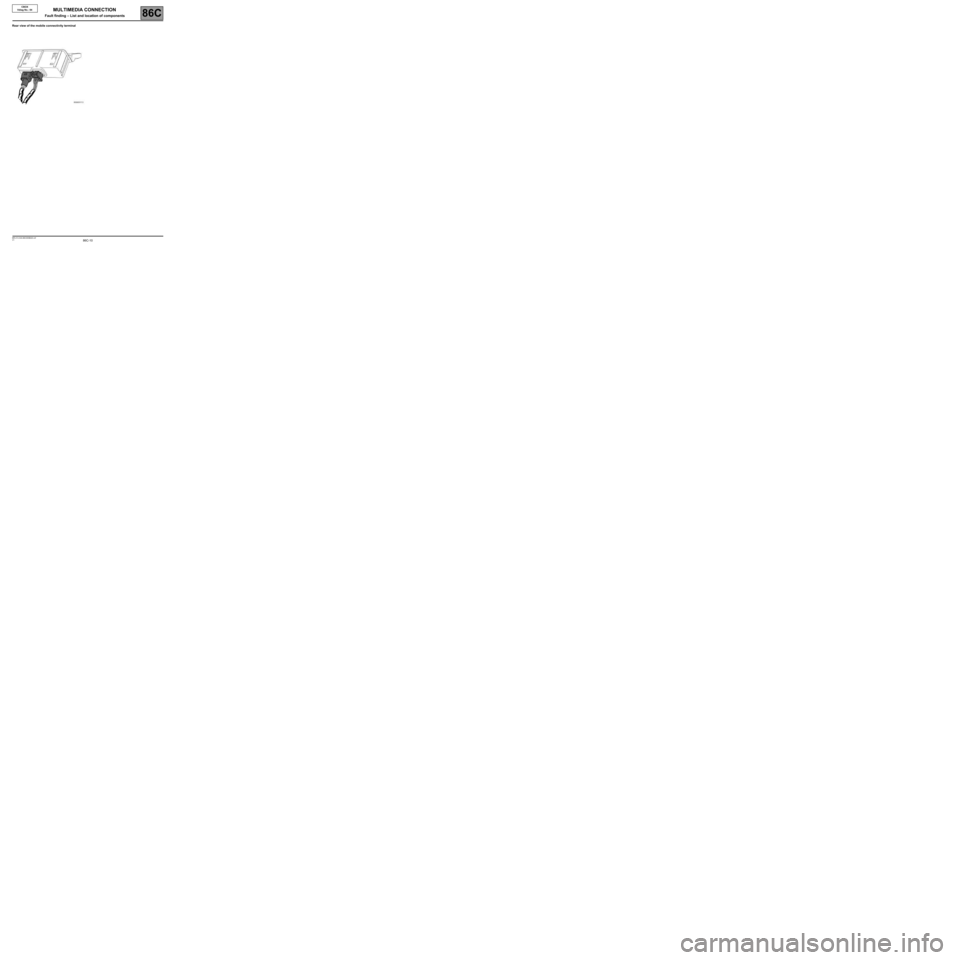
86C-10V1 MR-413-X44-86C000$020.mif
MULTIMEDIA CONNECTION
Fault finding – List and location of components86C
CBOX
Vdiag No.: 04
Rear view of the mobile connectivity terminal